Samson Media: Detailed Change Management Report for Digital Transition
VerifiedAdded on 2021/04/21
|10
|2037
|89
Report
AI Summary
This report details the change management process designed for Samson Media, addressing its decline in readership and profits. The report outlines the current situation, analyzing the company's challenges, including increased competition and a shift towards digital media. It proposes a strategic plan to transition from print to digital media, incorporating new content and features. The report covers external environmental factors, potential barriers such as stakeholder resistance and resource limitations, and change readiness indicators. It suggests strategies for embedding change, prioritizing leadership support, stakeholder communication, and employee skill development. The change particulars, including costs, benefits, and implementation strategies, are also detailed, along with a risk assessment and communication/training plans. The ultimate goal is to increase returns on capital by 8% within two years through a comprehensive digital transformation.

UNIT:
NAME:
DATE:
NAME:
DATE:
Paraphrase This Document
Need a fresh take? Get an instant paraphrase of this document with our AI Paraphraser
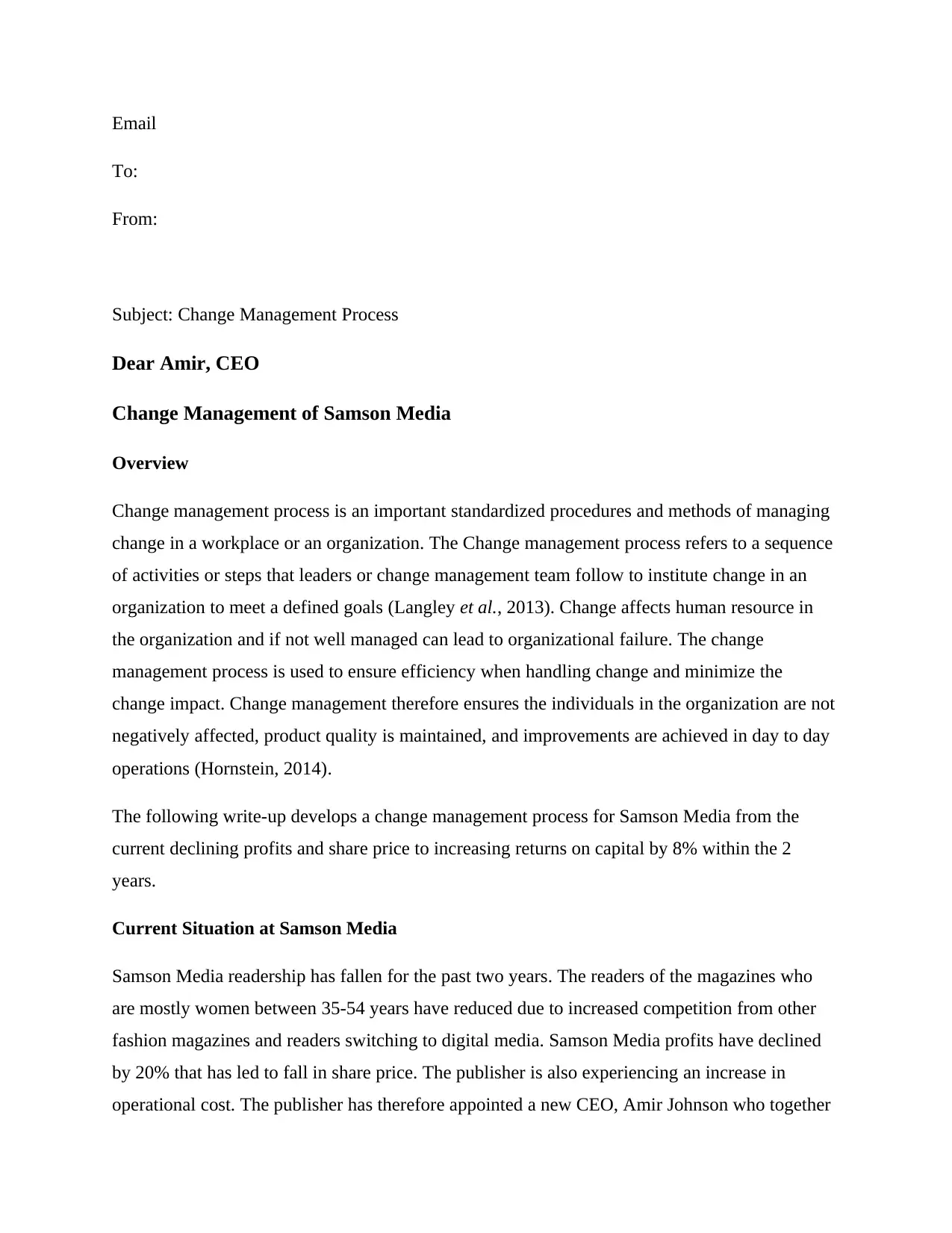
Email
To:
From:
Subject: Change Management Process
Dear Amir, CEO
Change Management of Samson Media
Overview
Change management process is an important standardized procedures and methods of managing
change in a workplace or an organization. The Change management process refers to a sequence
of activities or steps that leaders or change management team follow to institute change in an
organization to meet a defined goals (Langley et al., 2013). Change affects human resource in
the organization and if not well managed can lead to organizational failure. The change
management process is used to ensure efficiency when handling change and minimize the
change impact. Change management therefore ensures the individuals in the organization are not
negatively affected, product quality is maintained, and improvements are achieved in day to day
operations (Hornstein, 2014).
The following write-up develops a change management process for Samson Media from the
current declining profits and share price to increasing returns on capital by 8% within the 2
years.
Current Situation at Samson Media
Samson Media readership has fallen for the past two years. The readers of the magazines who
are mostly women between 35-54 years have reduced due to increased competition from other
fashion magazines and readers switching to digital media. Samson Media profits have declined
by 20% that has led to fall in share price. The publisher is also experiencing an increase in
operational cost. The publisher has therefore appointed a new CEO, Amir Johnson who together
To:
From:
Subject: Change Management Process
Dear Amir, CEO
Change Management of Samson Media
Overview
Change management process is an important standardized procedures and methods of managing
change in a workplace or an organization. The Change management process refers to a sequence
of activities or steps that leaders or change management team follow to institute change in an
organization to meet a defined goals (Langley et al., 2013). Change affects human resource in
the organization and if not well managed can lead to organizational failure. The change
management process is used to ensure efficiency when handling change and minimize the
change impact. Change management therefore ensures the individuals in the organization are not
negatively affected, product quality is maintained, and improvements are achieved in day to day
operations (Hornstein, 2014).
The following write-up develops a change management process for Samson Media from the
current declining profits and share price to increasing returns on capital by 8% within the 2
years.
Current Situation at Samson Media
Samson Media readership has fallen for the past two years. The readers of the magazines who
are mostly women between 35-54 years have reduced due to increased competition from other
fashion magazines and readers switching to digital media. Samson Media profits have declined
by 20% that has led to fall in share price. The publisher is also experiencing an increase in
operational cost. The publisher has therefore appointed a new CEO, Amir Johnson who together
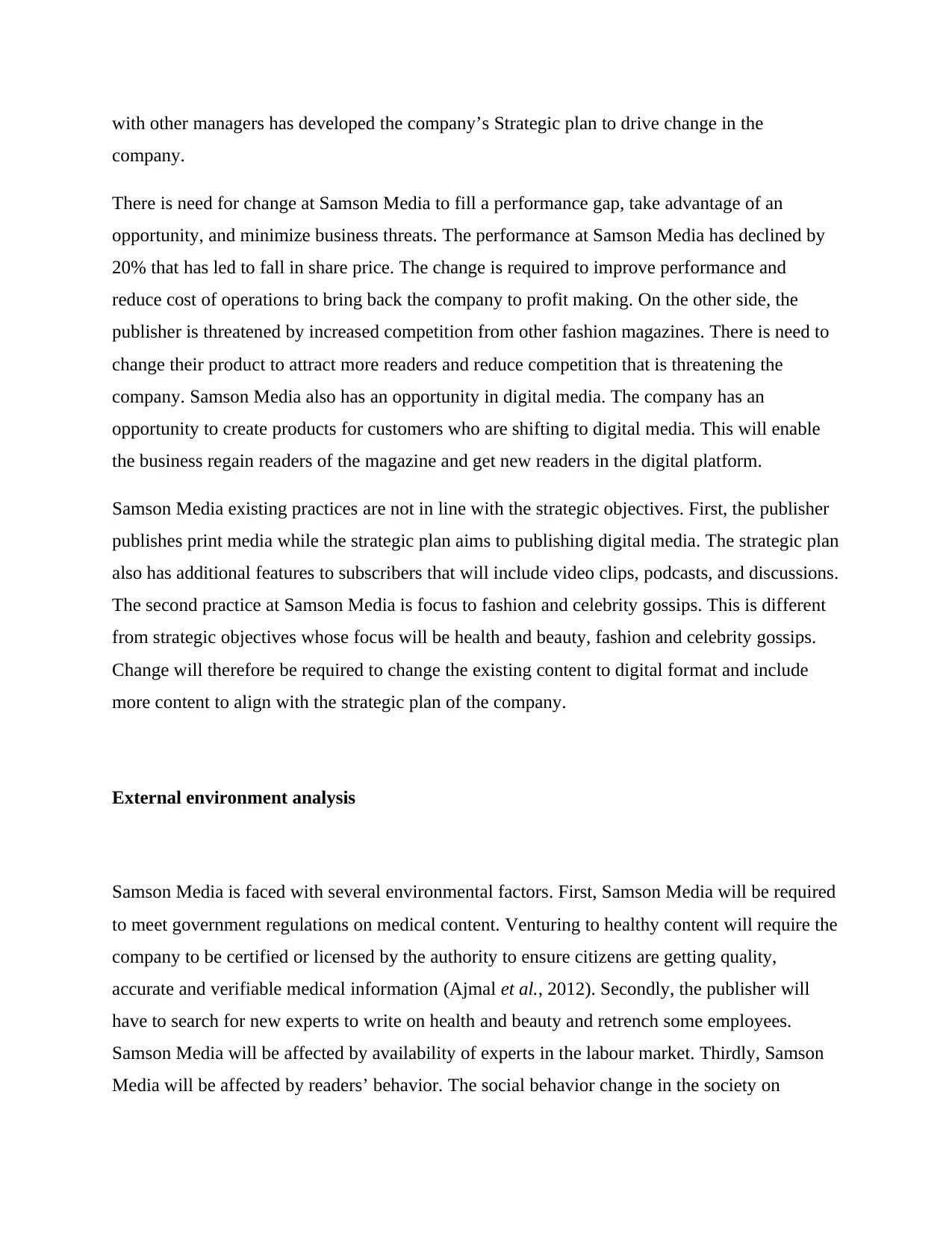
with other managers has developed the company’s Strategic plan to drive change in the
company.
There is need for change at Samson Media to fill a performance gap, take advantage of an
opportunity, and minimize business threats. The performance at Samson Media has declined by
20% that has led to fall in share price. The change is required to improve performance and
reduce cost of operations to bring back the company to profit making. On the other side, the
publisher is threatened by increased competition from other fashion magazines. There is need to
change their product to attract more readers and reduce competition that is threatening the
company. Samson Media also has an opportunity in digital media. The company has an
opportunity to create products for customers who are shifting to digital media. This will enable
the business regain readers of the magazine and get new readers in the digital platform.
Samson Media existing practices are not in line with the strategic objectives. First, the publisher
publishes print media while the strategic plan aims to publishing digital media. The strategic plan
also has additional features to subscribers that will include video clips, podcasts, and discussions.
The second practice at Samson Media is focus to fashion and celebrity gossips. This is different
from strategic objectives whose focus will be health and beauty, fashion and celebrity gossips.
Change will therefore be required to change the existing content to digital format and include
more content to align with the strategic plan of the company.
External environment analysis
Samson Media is faced with several environmental factors. First, Samson Media will be required
to meet government regulations on medical content. Venturing to healthy content will require the
company to be certified or licensed by the authority to ensure citizens are getting quality,
accurate and verifiable medical information (Ajmal et al., 2012). Secondly, the publisher will
have to search for new experts to write on health and beauty and retrench some employees.
Samson Media will be affected by availability of experts in the labour market. Thirdly, Samson
Media will be affected by readers’ behavior. The social behavior change in the society on
company.
There is need for change at Samson Media to fill a performance gap, take advantage of an
opportunity, and minimize business threats. The performance at Samson Media has declined by
20% that has led to fall in share price. The change is required to improve performance and
reduce cost of operations to bring back the company to profit making. On the other side, the
publisher is threatened by increased competition from other fashion magazines. There is need to
change their product to attract more readers and reduce competition that is threatening the
company. Samson Media also has an opportunity in digital media. The company has an
opportunity to create products for customers who are shifting to digital media. This will enable
the business regain readers of the magazine and get new readers in the digital platform.
Samson Media existing practices are not in line with the strategic objectives. First, the publisher
publishes print media while the strategic plan aims to publishing digital media. The strategic plan
also has additional features to subscribers that will include video clips, podcasts, and discussions.
The second practice at Samson Media is focus to fashion and celebrity gossips. This is different
from strategic objectives whose focus will be health and beauty, fashion and celebrity gossips.
Change will therefore be required to change the existing content to digital format and include
more content to align with the strategic plan of the company.
External environment analysis
Samson Media is faced with several environmental factors. First, Samson Media will be required
to meet government regulations on medical content. Venturing to healthy content will require the
company to be certified or licensed by the authority to ensure citizens are getting quality,
accurate and verifiable medical information (Ajmal et al., 2012). Secondly, the publisher will
have to search for new experts to write on health and beauty and retrench some employees.
Samson Media will be affected by availability of experts in the labour market. Thirdly, Samson
Media will be affected by readers’ behavior. The social behavior change in the society on
⊘ This is a preview!⊘
Do you want full access?
Subscribe today to unlock all pages.

Trusted by 1+ million students worldwide
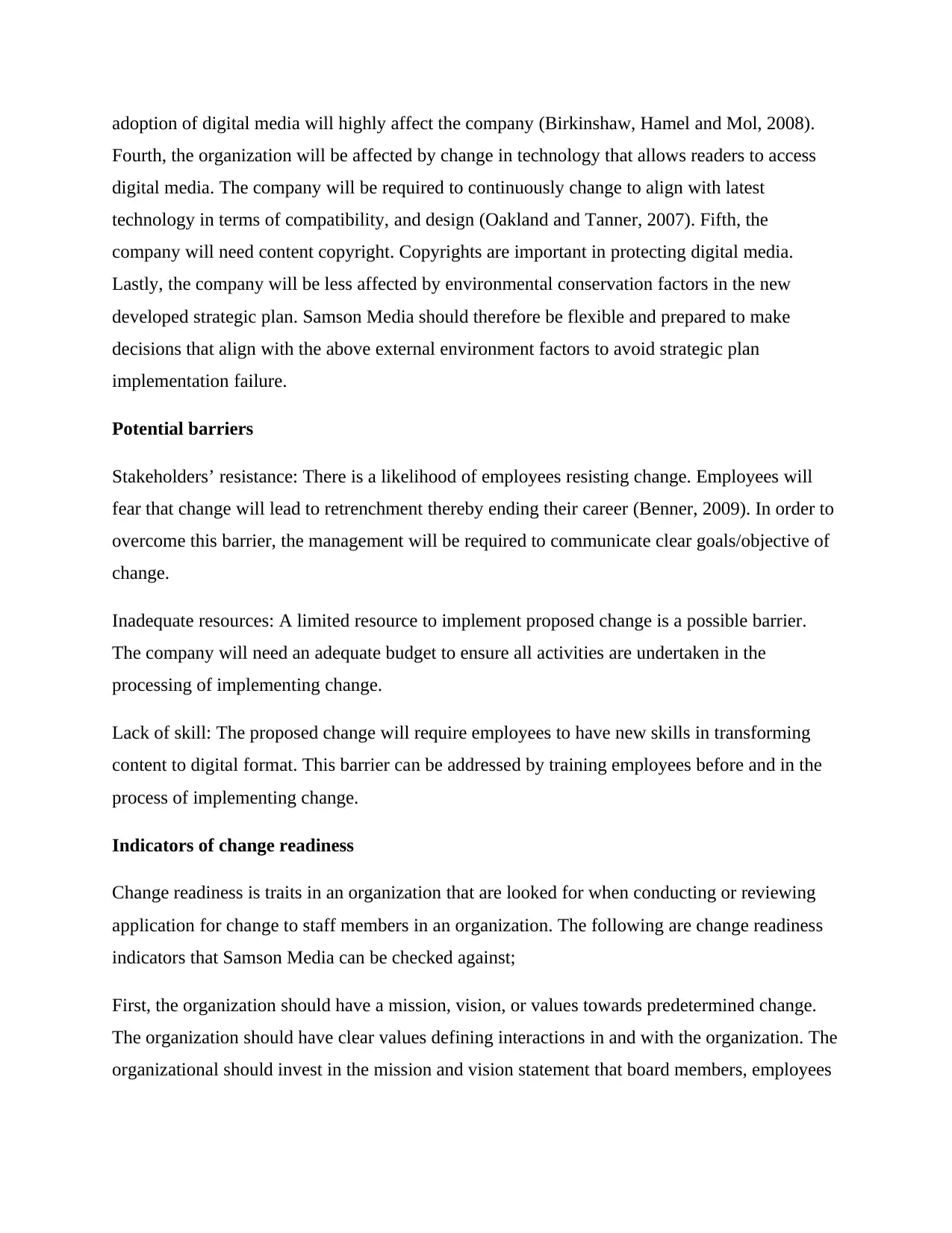
adoption of digital media will highly affect the company (Birkinshaw, Hamel and Mol, 2008).
Fourth, the organization will be affected by change in technology that allows readers to access
digital media. The company will be required to continuously change to align with latest
technology in terms of compatibility, and design (Oakland and Tanner, 2007). Fifth, the
company will need content copyright. Copyrights are important in protecting digital media.
Lastly, the company will be less affected by environmental conservation factors in the new
developed strategic plan. Samson Media should therefore be flexible and prepared to make
decisions that align with the above external environment factors to avoid strategic plan
implementation failure.
Potential barriers
Stakeholders’ resistance: There is a likelihood of employees resisting change. Employees will
fear that change will lead to retrenchment thereby ending their career (Benner, 2009). In order to
overcome this barrier, the management will be required to communicate clear goals/objective of
change.
Inadequate resources: A limited resource to implement proposed change is a possible barrier.
The company will need an adequate budget to ensure all activities are undertaken in the
processing of implementing change.
Lack of skill: The proposed change will require employees to have new skills in transforming
content to digital format. This barrier can be addressed by training employees before and in the
process of implementing change.
Indicators of change readiness
Change readiness is traits in an organization that are looked for when conducting or reviewing
application for change to staff members in an organization. The following are change readiness
indicators that Samson Media can be checked against;
First, the organization should have a mission, vision, or values towards predetermined change.
The organization should have clear values defining interactions in and with the organization. The
organizational should invest in the mission and vision statement that board members, employees
Fourth, the organization will be affected by change in technology that allows readers to access
digital media. The company will be required to continuously change to align with latest
technology in terms of compatibility, and design (Oakland and Tanner, 2007). Fifth, the
company will need content copyright. Copyrights are important in protecting digital media.
Lastly, the company will be less affected by environmental conservation factors in the new
developed strategic plan. Samson Media should therefore be flexible and prepared to make
decisions that align with the above external environment factors to avoid strategic plan
implementation failure.
Potential barriers
Stakeholders’ resistance: There is a likelihood of employees resisting change. Employees will
fear that change will lead to retrenchment thereby ending their career (Benner, 2009). In order to
overcome this barrier, the management will be required to communicate clear goals/objective of
change.
Inadequate resources: A limited resource to implement proposed change is a possible barrier.
The company will need an adequate budget to ensure all activities are undertaken in the
processing of implementing change.
Lack of skill: The proposed change will require employees to have new skills in transforming
content to digital format. This barrier can be addressed by training employees before and in the
process of implementing change.
Indicators of change readiness
Change readiness is traits in an organization that are looked for when conducting or reviewing
application for change to staff members in an organization. The following are change readiness
indicators that Samson Media can be checked against;
First, the organization should have a mission, vision, or values towards predetermined change.
The organization should have clear values defining interactions in and with the organization. The
organizational should invest in the mission and vision statement that board members, employees
Paraphrase This Document
Need a fresh take? Get an instant paraphrase of this document with our AI Paraphraser
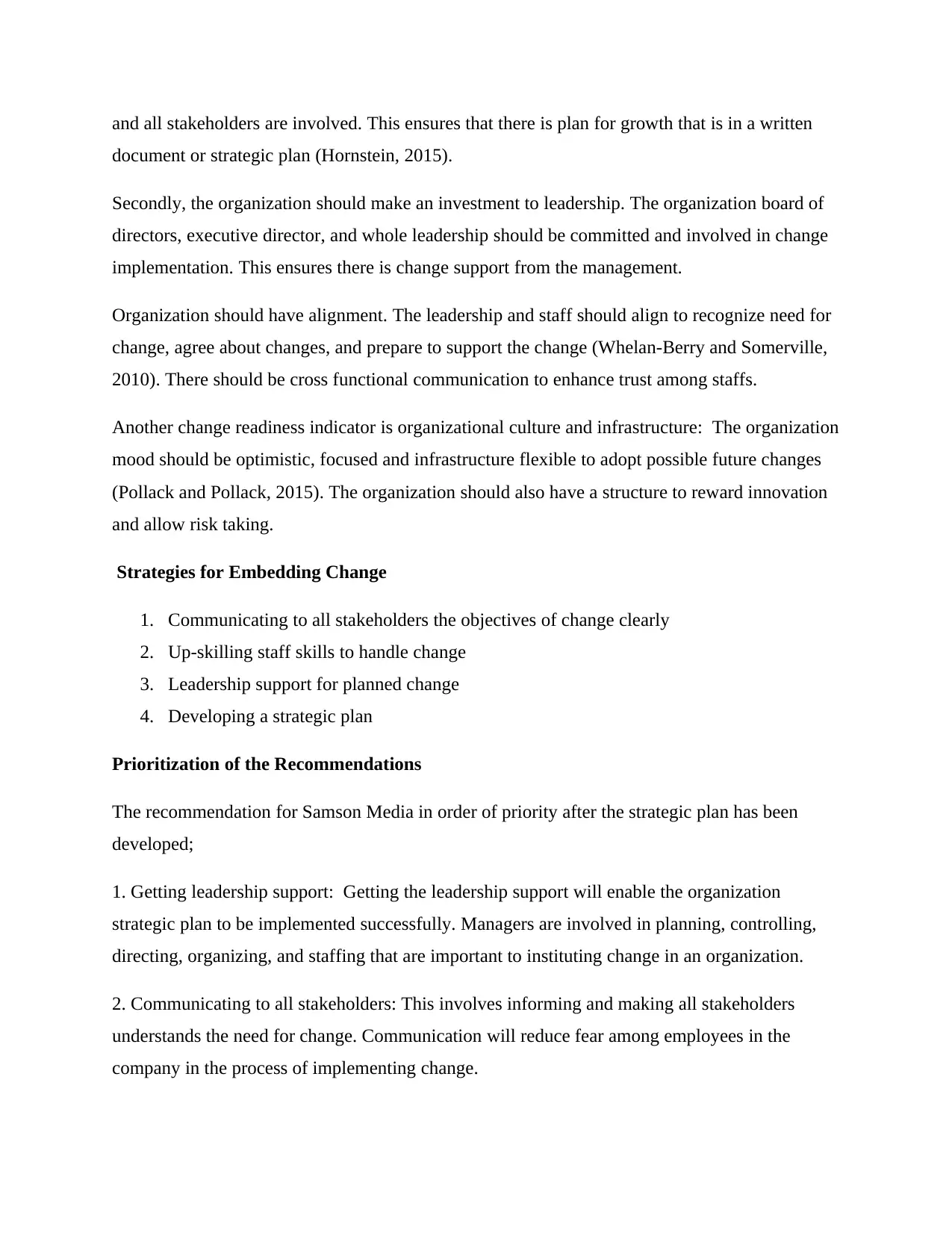
and all stakeholders are involved. This ensures that there is plan for growth that is in a written
document or strategic plan (Hornstein, 2015).
Secondly, the organization should make an investment to leadership. The organization board of
directors, executive director, and whole leadership should be committed and involved in change
implementation. This ensures there is change support from the management.
Organization should have alignment. The leadership and staff should align to recognize need for
change, agree about changes, and prepare to support the change (Whelan-Berry and Somerville,
2010). There should be cross functional communication to enhance trust among staffs.
Another change readiness indicator is organizational culture and infrastructure: The organization
mood should be optimistic, focused and infrastructure flexible to adopt possible future changes
(Pollack and Pollack, 2015). The organization should also have a structure to reward innovation
and allow risk taking.
Strategies for Embedding Change
1. Communicating to all stakeholders the objectives of change clearly
2. Up-skilling staff skills to handle change
3. Leadership support for planned change
4. Developing a strategic plan
Prioritization of the Recommendations
The recommendation for Samson Media in order of priority after the strategic plan has been
developed;
1. Getting leadership support: Getting the leadership support will enable the organization
strategic plan to be implemented successfully. Managers are involved in planning, controlling,
directing, organizing, and staffing that are important to instituting change in an organization.
2. Communicating to all stakeholders: This involves informing and making all stakeholders
understands the need for change. Communication will reduce fear among employees in the
company in the process of implementing change.
document or strategic plan (Hornstein, 2015).
Secondly, the organization should make an investment to leadership. The organization board of
directors, executive director, and whole leadership should be committed and involved in change
implementation. This ensures there is change support from the management.
Organization should have alignment. The leadership and staff should align to recognize need for
change, agree about changes, and prepare to support the change (Whelan-Berry and Somerville,
2010). There should be cross functional communication to enhance trust among staffs.
Another change readiness indicator is organizational culture and infrastructure: The organization
mood should be optimistic, focused and infrastructure flexible to adopt possible future changes
(Pollack and Pollack, 2015). The organization should also have a structure to reward innovation
and allow risk taking.
Strategies for Embedding Change
1. Communicating to all stakeholders the objectives of change clearly
2. Up-skilling staff skills to handle change
3. Leadership support for planned change
4. Developing a strategic plan
Prioritization of the Recommendations
The recommendation for Samson Media in order of priority after the strategic plan has been
developed;
1. Getting leadership support: Getting the leadership support will enable the organization
strategic plan to be implemented successfully. Managers are involved in planning, controlling,
directing, organizing, and staffing that are important to instituting change in an organization.
2. Communicating to all stakeholders: This involves informing and making all stakeholders
understands the need for change. Communication will reduce fear among employees in the
company in the process of implementing change.
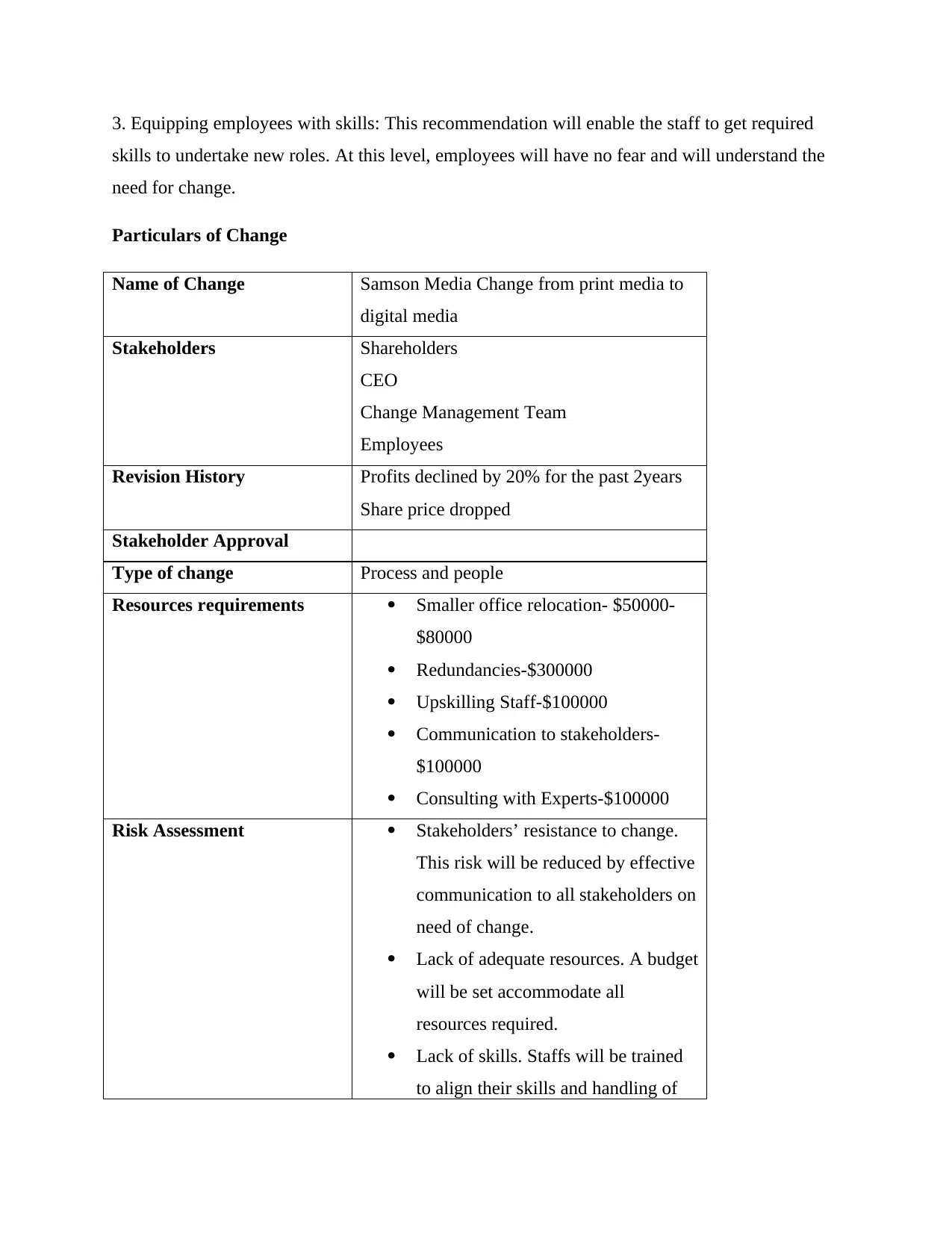
3. Equipping employees with skills: This recommendation will enable the staff to get required
skills to undertake new roles. At this level, employees will have no fear and will understand the
need for change.
Particulars of Change
Name of Change Samson Media Change from print media to
digital media
Stakeholders Shareholders
CEO
Change Management Team
Employees
Revision History Profits declined by 20% for the past 2years
Share price dropped
Stakeholder Approval
Type of change Process and people
Resources requirements Smaller office relocation- $50000-
$80000
Redundancies-$300000
Upskilling Staff-$100000
Communication to stakeholders-
$100000
Consulting with Experts-$100000
Risk Assessment Stakeholders’ resistance to change.
This risk will be reduced by effective
communication to all stakeholders on
need of change.
Lack of adequate resources. A budget
will be set accommodate all
resources required.
Lack of skills. Staffs will be trained
to align their skills and handling of
skills to undertake new roles. At this level, employees will have no fear and will understand the
need for change.
Particulars of Change
Name of Change Samson Media Change from print media to
digital media
Stakeholders Shareholders
CEO
Change Management Team
Employees
Revision History Profits declined by 20% for the past 2years
Share price dropped
Stakeholder Approval
Type of change Process and people
Resources requirements Smaller office relocation- $50000-
$80000
Redundancies-$300000
Upskilling Staff-$100000
Communication to stakeholders-
$100000
Consulting with Experts-$100000
Risk Assessment Stakeholders’ resistance to change.
This risk will be reduced by effective
communication to all stakeholders on
need of change.
Lack of adequate resources. A budget
will be set accommodate all
resources required.
Lack of skills. Staffs will be trained
to align their skills and handling of
⊘ This is a preview!⊘
Do you want full access?
Subscribe today to unlock all pages.

Trusted by 1+ million students worldwide
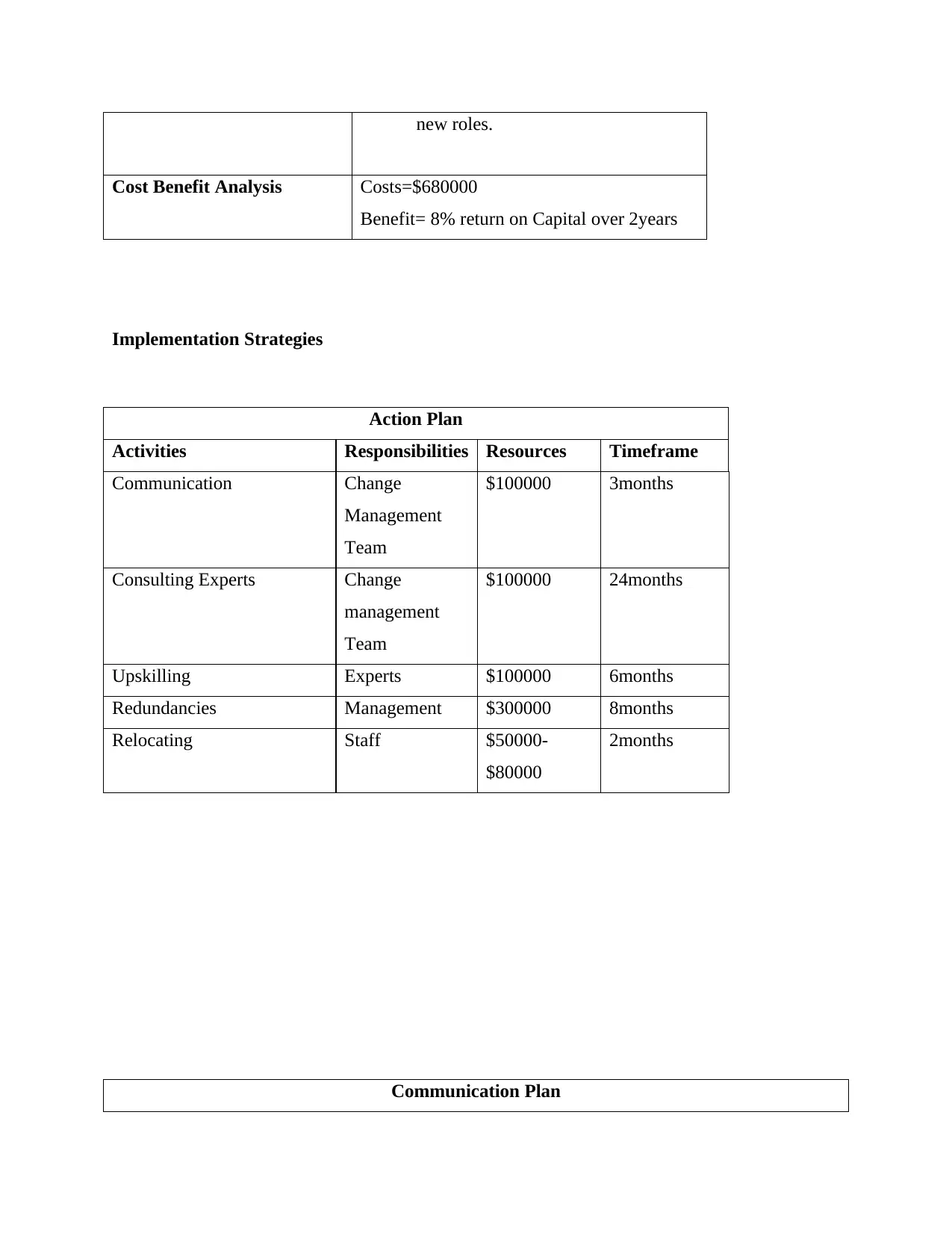
new roles.
Cost Benefit Analysis Costs=$680000
Benefit= 8% return on Capital over 2years
Implementation Strategies
Action Plan
Activities Responsibilities Resources Timeframe
Communication Change
Management
Team
$100000 3months
Consulting Experts Change
management
Team
$100000 24months
Upskilling Experts $100000 6months
Redundancies Management $300000 8months
Relocating Staff $50000-
$80000
2months
Communication Plan
Cost Benefit Analysis Costs=$680000
Benefit= 8% return on Capital over 2years
Implementation Strategies
Action Plan
Activities Responsibilities Resources Timeframe
Communication Change
Management
Team
$100000 3months
Consulting Experts Change
management
Team
$100000 24months
Upskilling Experts $100000 6months
Redundancies Management $300000 8months
Relocating Staff $50000-
$80000
2months
Communication Plan
Paraphrase This Document
Need a fresh take? Get an instant paraphrase of this document with our AI Paraphraser
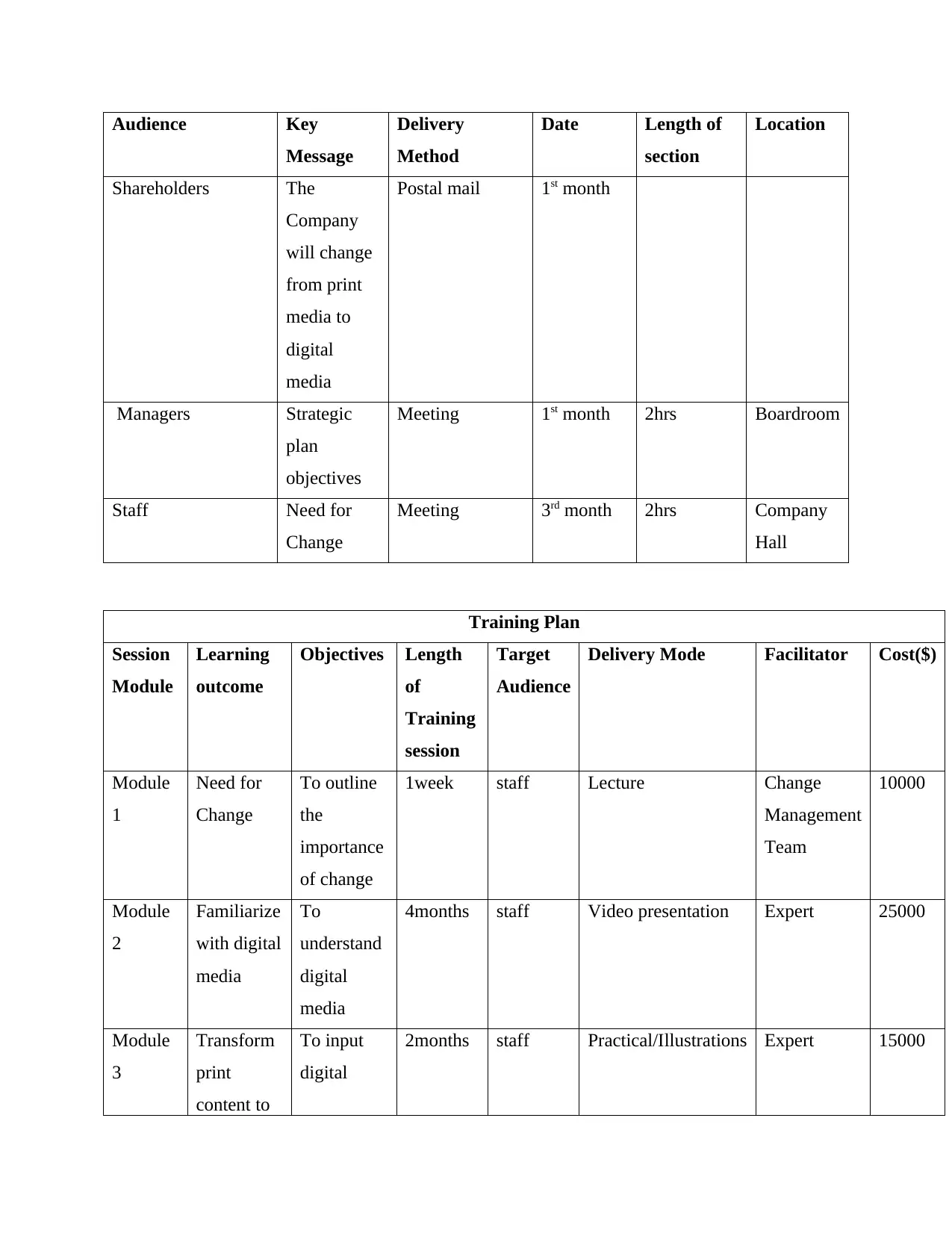
Audience Key
Message
Delivery
Method
Date Length of
section
Location
Shareholders The
Company
will change
from print
media to
digital
media
Postal mail 1st month
Managers Strategic
plan
objectives
Meeting 1st month 2hrs Boardroom
Staff Need for
Change
Meeting 3rd month 2hrs Company
Hall
Training Plan
Session
Module
Learning
outcome
Objectives Length
of
Training
session
Target
Audience
Delivery Mode Facilitator Cost($)
Module
1
Need for
Change
To outline
the
importance
of change
1week staff Lecture Change
Management
Team
10000
Module
2
Familiarize
with digital
media
To
understand
digital
media
4months staff Video presentation Expert 25000
Module
3
Transform
print
content to
To input
digital
2months staff Practical/Illustrations Expert 15000
Message
Delivery
Method
Date Length of
section
Location
Shareholders The
Company
will change
from print
media to
digital
media
Postal mail 1st month
Managers Strategic
plan
objectives
Meeting 1st month 2hrs Boardroom
Staff Need for
Change
Meeting 3rd month 2hrs Company
Hall
Training Plan
Session
Module
Learning
outcome
Objectives Length
of
Training
session
Target
Audience
Delivery Mode Facilitator Cost($)
Module
1
Need for
Change
To outline
the
importance
of change
1week staff Lecture Change
Management
Team
10000
Module
2
Familiarize
with digital
media
To
understand
digital
media
4months staff Video presentation Expert 25000
Module
3
Transform
content to
To input
digital
2months staff Practical/Illustrations Expert 15000
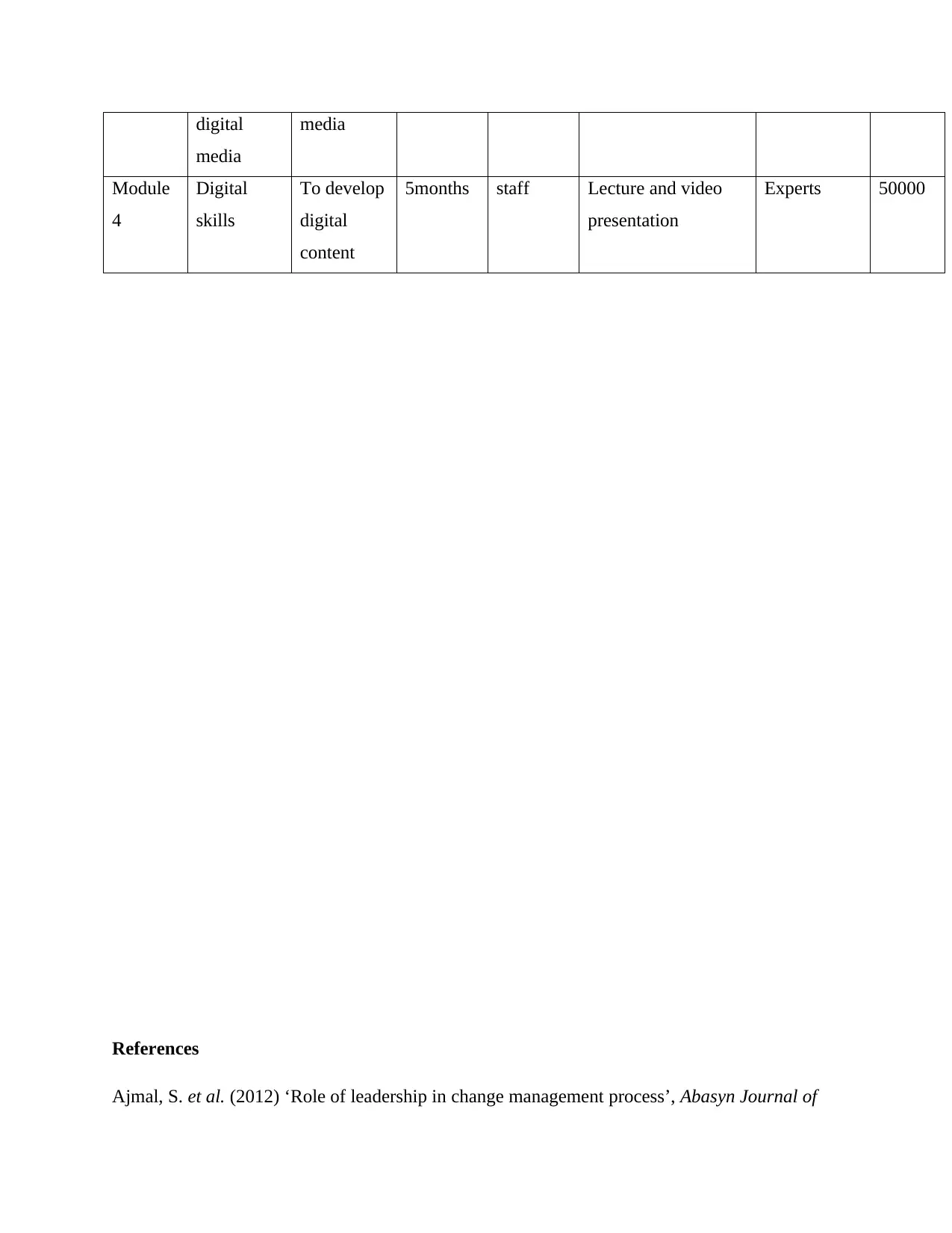
digital
media
media
Module
4
Digital
skills
To develop
digital
content
5months staff Lecture and video
presentation
Experts 50000
References
Ajmal, S. et al. (2012) ‘Role of leadership in change management process’, Abasyn Journal of
media
media
Module
4
Digital
skills
To develop
digital
content
5months staff Lecture and video
presentation
Experts 50000
References
Ajmal, S. et al. (2012) ‘Role of leadership in change management process’, Abasyn Journal of
⊘ This is a preview!⊘
Do you want full access?
Subscribe today to unlock all pages.

Trusted by 1+ million students worldwide
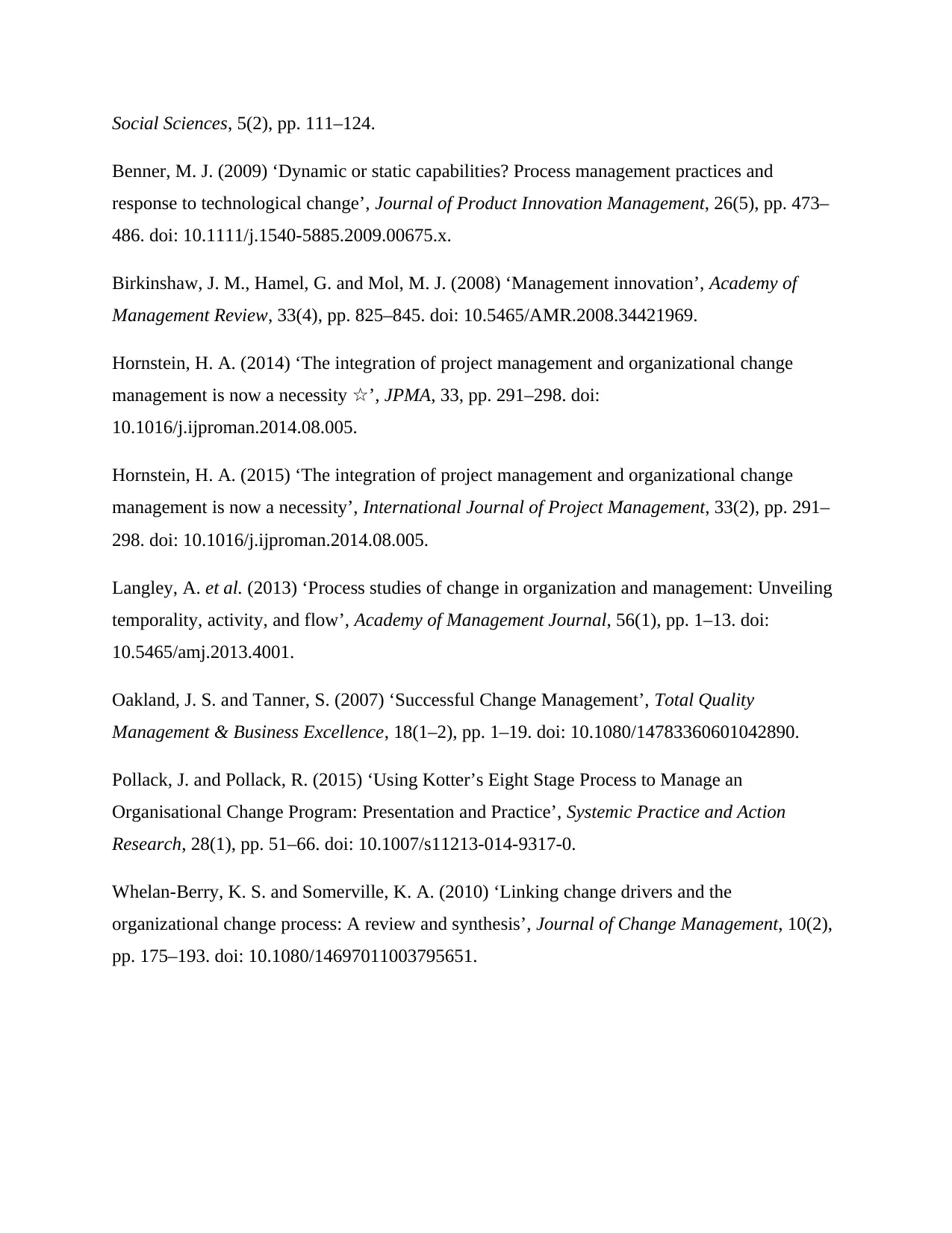
Social Sciences, 5(2), pp. 111–124.
Benner, M. J. (2009) ‘Dynamic or static capabilities? Process management practices and
response to technological change’, Journal of Product Innovation Management, 26(5), pp. 473–
486. doi: 10.1111/j.1540-5885.2009.00675.x.
Birkinshaw, J. M., Hamel, G. and Mol, M. J. (2008) ‘Management innovation’, Academy of
Management Review, 33(4), pp. 825–845. doi: 10.5465/AMR.2008.34421969.
Hornstein, H. A. (2014) ‘The integration of project management and organizational change
management is now a necessity ☆’, JPMA, 33, pp. 291–298. doi:
10.1016/j.ijproman.2014.08.005.
Hornstein, H. A. (2015) ‘The integration of project management and organizational change
management is now a necessity’, International Journal of Project Management, 33(2), pp. 291–
298. doi: 10.1016/j.ijproman.2014.08.005.
Langley, A. et al. (2013) ‘Process studies of change in organization and management: Unveiling
temporality, activity, and flow’, Academy of Management Journal, 56(1), pp. 1–13. doi:
10.5465/amj.2013.4001.
Oakland, J. S. and Tanner, S. (2007) ‘Successful Change Management’, Total Quality
Management & Business Excellence, 18(1–2), pp. 1–19. doi: 10.1080/14783360601042890.
Pollack, J. and Pollack, R. (2015) ‘Using Kotter’s Eight Stage Process to Manage an
Organisational Change Program: Presentation and Practice’, Systemic Practice and Action
Research, 28(1), pp. 51–66. doi: 10.1007/s11213-014-9317-0.
Whelan-Berry, K. S. and Somerville, K. A. (2010) ‘Linking change drivers and the
organizational change process: A review and synthesis’, Journal of Change Management, 10(2),
pp. 175–193. doi: 10.1080/14697011003795651.
Benner, M. J. (2009) ‘Dynamic or static capabilities? Process management practices and
response to technological change’, Journal of Product Innovation Management, 26(5), pp. 473–
486. doi: 10.1111/j.1540-5885.2009.00675.x.
Birkinshaw, J. M., Hamel, G. and Mol, M. J. (2008) ‘Management innovation’, Academy of
Management Review, 33(4), pp. 825–845. doi: 10.5465/AMR.2008.34421969.
Hornstein, H. A. (2014) ‘The integration of project management and organizational change
management is now a necessity ☆’, JPMA, 33, pp. 291–298. doi:
10.1016/j.ijproman.2014.08.005.
Hornstein, H. A. (2015) ‘The integration of project management and organizational change
management is now a necessity’, International Journal of Project Management, 33(2), pp. 291–
298. doi: 10.1016/j.ijproman.2014.08.005.
Langley, A. et al. (2013) ‘Process studies of change in organization and management: Unveiling
temporality, activity, and flow’, Academy of Management Journal, 56(1), pp. 1–13. doi:
10.5465/amj.2013.4001.
Oakland, J. S. and Tanner, S. (2007) ‘Successful Change Management’, Total Quality
Management & Business Excellence, 18(1–2), pp. 1–19. doi: 10.1080/14783360601042890.
Pollack, J. and Pollack, R. (2015) ‘Using Kotter’s Eight Stage Process to Manage an
Organisational Change Program: Presentation and Practice’, Systemic Practice and Action
Research, 28(1), pp. 51–66. doi: 10.1007/s11213-014-9317-0.
Whelan-Berry, K. S. and Somerville, K. A. (2010) ‘Linking change drivers and the
organizational change process: A review and synthesis’, Journal of Change Management, 10(2),
pp. 175–193. doi: 10.1080/14697011003795651.
1 out of 10
Related Documents
Your All-in-One AI-Powered Toolkit for Academic Success.
+13062052269
info@desklib.com
Available 24*7 on WhatsApp / Email
![[object Object]](/_next/static/media/star-bottom.7253800d.svg)
Unlock your academic potential
Copyright © 2020–2025 A2Z Services. All Rights Reserved. Developed and managed by ZUCOL.





